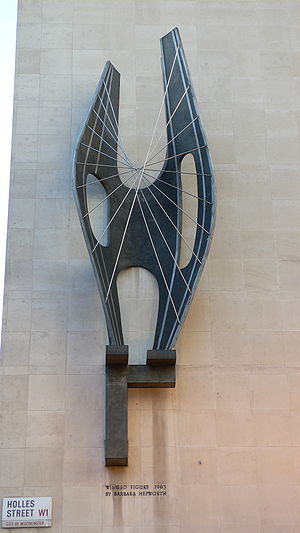
Dame Jocelyn Barbara Hepworth was an English artist and sculptor. Her work exemplifies Modernism and in particular modern sculpture. Along with artists such as Ben Nicholson and Naum Gabo, Hepworth was a leading figure in the colony of artists who resided in St Ives during the Second World War.

Sir Jacob Epstein was an American-British sculptor who helped pioneer modern sculpture. He was born in the United States, and moved to Europe in 1902, becoming a British subject in 1910.

The Barbara Hepworth Museum and Sculpture Garden in St Ives, Cornwall preserves the 20th-century sculptor Barbara Hepworth's studio and garden much as they were when she lived and worked there. She purchased the site in 1949 and lived and worked there for 26 years until her death in a fire on the premises in 1975.
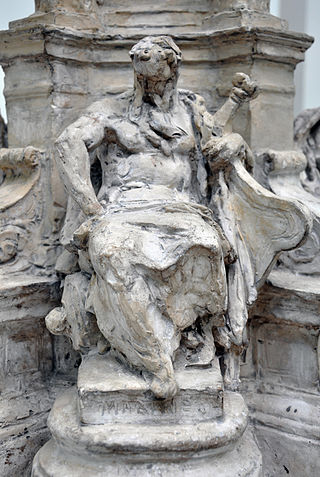
A maquette is a scale model or rough draft of an unfinished sculpture. An equivalent term is bozzetto, from the Italian word for "sketch".

Henry Spencer Moore was an English artist. He is best known for his semi-abstract monumental bronze sculptures which are located around the world as public works of art. As well as sculpture, Moore produced many drawings, including a series depicting Londoners sheltering from the Blitz during the Second World War, along with other graphic works on paper.
Denis Adeane Mitchell was an English abstract sculptor who worked mainly in bronze and wood. A prominent member of the St Ives group of artists, he worked as an assistant to Barbara Hepworth for many years.
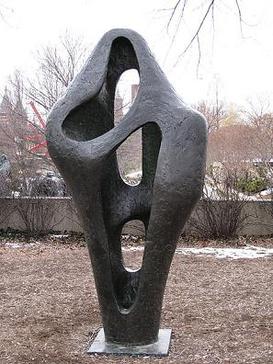
Figure for Landscape is a bronze sculpture by Barbara Hepworth, modeled in 1960.

Sea Form (Atlantic) (BH 362) is a 1964 bronze sculpture by English artist Barbara Hepworth. It measures 204 cm × 107 cm × 73 cm (80 in × 42 in × 29 in).

Two Forms (Divided Circle) (BH 477) is a bronze sculpture by Barbara Hepworth, designed in 1969. Six numbered copies were cast, plus one (0/6) retained by the sculptor. The sculpture's dimensions are 237 centimetres (93 in) by 234 centimetres (92 in) by 54 centimetres (21 in).

Sphere with Inner Form is a bronze sculpture by English artist Barbara Hepworth, with six castings made in 1963 and two more 1965. It is sometimes interpreted as a child in a pregnant woman's womb, or as a metaphor for the creation of a sculpture.

Reclining Figure: Festival is a bronze sculpture by English artist Henry Moore, commissioned by the Arts Council in 1949 for the Festival of Britain in 1951. The sculpture can be viewed as an abstraction of a reclining female human figure, resting on two arms, with a small head.
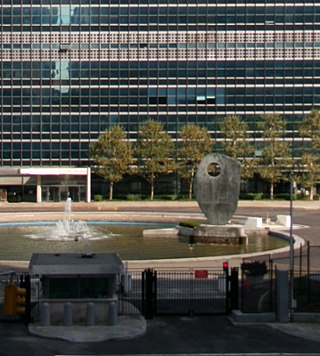
Single Form is a monumental bronze sculpture by the British artist Barbara Hepworth. It is her largest work, and one of her most prominent public commissions, displayed since 1964 in a circular water feature that forms a traffic island at the Headquarters of the United Nations in New York City, outside the United Nations Secretariat Building and the Dag Hammarskjöld Library. It is also the largest artwork cast by the Morris Singer foundry.
Meridian is a bronze sculpture by British artist Barbara Hepworth. It is an early example of her public commissions, commissioned for State House, a new 16-storey office block constructed at 66–71 High Holborn, London, in the early 1960s. The sculpture was made in 1958–59, and erected in 1960. When the building was demolished in 1990, the sculpture was sold and moved to the Donald M. Kendall Sculpture Gardens in Purchase, New York.

Hubert Cyril Dalwood was a British sculptor. He was widely known as 'Nibs'.

Holles Street is a street in Marylebone in the City of Westminster in central London that runs from the south side of Cavendish Square to Oxford Street.
Turning Forms is a concrete sculpture by Barbara Hepworth, one of her first public commissions, made in 1950 for the Festival of Britain. It was one of two Hepworth commissions for the Festival: the other was a sculpture of abstract standing figures, Contrapuntal Forms, now in Harlow. Turning Forms has been sited at a school in St Albans since 1953. Both of Hepworth's sculptures were listed at Grade II in 1998.

Locking Piece is a sculpture by Henry Moore. It comprises two interlocking forms holding a third element between them, on a bronze base. It is usually mounted on a separate plinth. The sculpture was created in 1962–1964, and bronze casts were made in 1964–1967.

Four-Square is a 4.3 metres (14 ft) high bronze sculpture by British artist Barbara Hepworth. It was cast in 1966 in an edition of 3+1. The four casts are displayed at the Barbara Hepworth Museum, the Norton Simon Museum, Churchill College, Cambridge, and the Mayo Clinic.
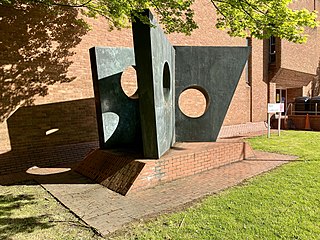
Three Obliques (Walk In) is a 1968 sculpture by Barbara Hepworth. Three casts exist; two are in private collections and a third is displayed outside the Cardiff University School of Music in Cardiff, Wales. It is cast in bronze on a monumental scale.
The Palais de Danse is a former cinema, dance hall, ballet school and auction house in St Ives, Cornwall which was a studio for sculptor and artist Barbara Hepworth from 1961 until her death in 1975. After her death, the Palais was kept by her family until it was donated to Tate in 2015. In 2020, Historic England designated it a Grade II listed building.
